The Optimum Interval Time of Layered Cement Composites with the Incorporation of Edge-Oxidized Graphene Oxide
Abstract
:1. Introduction
2. Experimental Design
2.1. Materials
2.2. Mixture Design and Casting
3. Tests
3.1. Setting Time
3.2. Mechanical Properties
- flexural strength (Mpa);
- the maximum applied load (N);
- the sample length (mm);
- the sample height (mm);
- the sample width (mm).

3.3. Microstructural Tests
4. Results and Discussion
4.1. Setting Time
4.2. Mechanical Properties
4.2.1. Compressive Strength
4.2.2. Flexural Strength
4.2.3. Statistical Analysis
4.3. Microstructure Analysis
4.3.1. Porosity and Residual Strength
4.3.2. Scanning Electron Microscopy (SEM)
5. Conclusions
- -
- A 0.10% concentration of EOGO delayed the setting time of cement by 15 min.
- -
- The effect of EOGO seemed to be more on splitting strength than on flexural strength;
- -
- The benefit of incorporating EOGO on the contact surfaces of the two different cement composites increased with the increase in the curing time.
- -
- EOGO did not show significant improvement in flexural strength because both cement composites were simultaneously exposed to tensile strength at the bottom fiber, so the weakest material (cement mortar in the current study) governed the strength behavior.
- -
- Considering the 28-day residual compressive strength, the samples with EOGO exhibited better behavior under the condition in which the first layer did not reach its final set.
- -
- The time interval of 6 h (or after the final setting and before hardening) resulted in the best performance in the compressive strength, porosity, and residual strength compared to other interval times of casting two different cement composites.
- -
- Utilizing cement composite containing EOGO at regions exposed to tensile stresses would be beneficial to resisting high loads.
Author Contributions
Funding
Data Availability Statement
Acknowledgments
Conflicts of Interest
References
- Görtz, J.; Zafar, A.; Wieprecht, S.; Terheiden, K. Aperture and permeability of aged concrete joints. Constr. Build. Mater. 2021, 307, 124783. [Google Scholar] [CrossRef]
- ACI Committee. 224 Joints in Concrete Construction; American Concrete Institute: Columbia, MD, USA, 2001. [Google Scholar]
- Kadhum, S.; Al-Zaidee, S. A review of previous studies on the construction joints in reinforced concrete beams. Des. Eng. 2021, 8, 16464–16472. [Google Scholar]
- Al-Rifaie, A.; Al-Hassani, H.; Shubbar, A.A. Flexural behaviour of reinforced concrete beams with horizontal construction joints. IOP Conf. Series: Mater. Sci. Eng. 2021, 1090, 012003. [Google Scholar] [CrossRef]
- Issa, C.A.; Gerges, N.N.; Fawaz, S. The effect of concrete vertical construction joints on the modulus of rupture. Case Stud. Constr. Mater. 2014, 1, 25–32. [Google Scholar] [CrossRef]
- Jiang, H.; Shao, T.; Fang, Z.; Xiao, J.; Hu, Z. Shear-friction behavior of grooved construction joints between a precast UHPC girder and a cast-in-place concrete slab. Eng. Struct. 2020, 228, 111610. [Google Scholar] [CrossRef]
- Tullini, N.; Minghini, F. Grouted sleeve connections used in precast reinforced concrete construction—Experimental investigation of a column-to-column joint. Eng. Struct. 2016, 127, 784–803. [Google Scholar] [CrossRef]
- Wang, X.; Sadati, S.; Taylor, P.; Li, C.; Wang, X.; Sha, A. Material characterization to assess effectiveness of surface treatment to prevent joint deterioration from oxychloride formation mechanism. Cem. Concr. Compos. 2019, 104, 103394. [Google Scholar] [CrossRef]
- Gerges, N.N.; Issa, C.A.; Fawaz, S. The effect of construction joints on the flexural bending capacity of singly reinforced beams. Case Stud. Constr. Mater. 2016, 5, 112–123. [Google Scholar] [CrossRef]
- Gerges, N.N.; Issa, C.A.; Fawaz, S. Effect of construction joints on the splitting tensile strength of concrete. Case Stud. Constr. Mater. 2015, 3, 83–91. [Google Scholar] [CrossRef]
- Lin, C.; Wei, W.; Hu, Y.H. Catalytic behavior of graphene oxide for cement hydration process. J. Phys. Chem. Solids 2016, 89, 128–133. [Google Scholar] [CrossRef]
- Warner, J.; Schäffel, F.; Bachmatiuk, A.; Rümmeli, M. Graphene Fundamentals and Emergent Applications; Elsevier: Gainesville, FL, USA, 2013. [Google Scholar]
- Khawaji, M.; Cho, B.H.; Nam, B.H.; Alharbi, R.; An, J. Edge-oxidized graphene oxide as additive in fiber-reinforced concrete: Effects on fresh and hardened properties. J. Mater. Civ. Eng. 2020, 32, 04020028. [Google Scholar] [CrossRef]
- An, J.; Nam, B.H.; Alharbi, Y.; Cho, B.H.; Khawaji, M. Edge-oxidized graphene oxide (EOGO) in cement composites: Cement hydration and microstructure. Compos. B Eng. 2019, 173, 106795. [Google Scholar] [CrossRef]
- Gong, K.; Pan, Z.; Korayem, A.H.; Qiu, L.; Li, D.; Collins, F.; Wang, C.M.; Duan, W.H. Reinforcing effects of graphene oxide on portland cement paste. J. Mater. Civ. Eng. 2015, 27, 0001125. [Google Scholar] [CrossRef]
- Zhao, L.; Guo, X.; Liu, Y.; Ge, C.; Guo, L.; Shu, X.; Liu, J. Synergistic effects of silica nanoparticles/polycarboxylate superplasticizer modified graphene oxide on mechanical behavior and hydration process of cement composites. RSC Adv. 2017, 7, 16688–16702. [Google Scholar] [CrossRef]
- Li, X.; Lu, Z.; Chuah, S.; Li, W.; Liu, Y.; Duan, W.H.; Li, Z. Effects of graphene oxide aggregates on hydration degree, sorptivity, and tensile splitting strength of cement paste. Compos. Part A Appl. Sci. Manuf. 2017, 100, 1–8. [Google Scholar] [CrossRef]
- Wang, Q.; Wang, J.; Lu, C.X.; Liu, B.W.; Zhang, K.; Li, C.Z. Influence of graphene oxide additions on the microstructure and mechanical strength of cement. New Carbon Mater. 2015, 30, 349–356. [Google Scholar] [CrossRef]
- Lv, S.; Ma, Y.; Qiu, C.; Sun, T.; Liu, J.; Zhou, Q. Effect of graphene oxide nanosheets of microstructure and mechanical properties of cement composites. Constr. Build. Mater. 2013, 49, 121–127. [Google Scholar] [CrossRef]
- Lv, S.; Liu, J.; Sun, T.; Ma, Y.; Zhou, Q. Effect of GO nanosheets on shapes of cement hydration crystals and their formation process. Constr. Build. Mater. 2014, 64, 231–239. [Google Scholar] [CrossRef]
- Yang, H.; Monasterio, M.; Cui, H.; Han, N. Experimental study of the effects of graphene oxide on microstructure and properties of cement paste composite. Compos. Part A Appl. Sci. Manuf. 2017, 102, 263–272. [Google Scholar] [CrossRef]
- Li, W.; Li, X.; Chen, S.J.; Liu, Y.M.; Duan, W.H.; Shah, S.P. Effects of graphene oxide on early-age hydration and electrical resistivity of Portland cement paste. Constr. Build. Mater. 2017, 136, 506–514. [Google Scholar] [CrossRef]
- Chuah, S.; Li, W.; Chen, S.J.; Sanjayan, J.G.; Duan, W.H. Investigation on dispersion of graphene oxide in cement composite using different surfactant treatments. Constr. Build. Mater. 2018, 161, 519–527. [Google Scholar] [CrossRef]
- Pan, Z.; He, L.; Qiu, L.; Korayem, A.H.; Li, G.; Zhu, J.W.; Collins, F.; Li, D.; Duan, W.H.; Wang, M.C. Mechanical properties and microstructure of a graphene oxide-cement composite. Cem. Concr. Compos. 2015, 58, 140–147. [Google Scholar] [CrossRef]
- Khawaji, M.; Alamri, M. Potential of enhancing the joint of adjacent cement composites by incorporating edge-oxidized graphene oxide. Case Stud. Constr. Mater. 2024, 21, e03540. [Google Scholar] [CrossRef]
- Liu, S.; Lu, F.; Chen, Y.; Dong, B.; Du, H.; Li, X. Efficient use of graphene oxide in layered cement mortar. Materials 2022, 15, 2181. [Google Scholar] [CrossRef] [PubMed]
- Li, X.; Li, C.; Liu, Y.; Chen, S.J.; Wang, C.M.; Sanjayan, J.G.; Duan, W.H. Improvement of mechanical properties by incorporating graphene oxide into cement mortar. Mech. Adv. Mater. Struct. 2016, 25, 1313–1322. [Google Scholar] [CrossRef]
- ASTM C 150/C150M; Standard Specification for Portland Cement. ASTM: West Conshohocken, PA, USA, 2017.
- Asbury Carbons. Available online: https://asbury.com (accessed on 26 April 2022).
- Garmor. Available online: http://www.garmortech.com/technology.htm (accessed on 26 April 2022).
- ASTM C305-14; Standard Practice for Mechanical Mixing of Hydraulic Cement Pastes and Mortars of Plastic Consistency. ASTM: West Conshohocken, PA, USA, 2020. [CrossRef]
- Li, X.; Wang, L.; Liu, Y.; Li, W.; Dong, B.; Duan, W.H. Dispersion of graphene oxide agglomerates in cement paste and its effects on electrical resistivity and flexural strength. Cem. Concr. Compos. 2018, 92, 145–154. [Google Scholar] [CrossRef]
- Alharbi, Y.; An, J.; Cho, B.H.; Khawaji, M.; Chung, W.; Nam, B.H. Mechanical and sorptivity characteristics of edge-oxidized graphene oxide (EOGO)-cement composites: Dry-and wet-mix design methods. Nanomaterials 2018, 8, 718. [Google Scholar] [CrossRef]
- Neville, A.M.; Brooks, J.J. Concrete Technology; Pearson Education Limited: London, UK, 2001. [Google Scholar]
- Kosmatka, S.H.; Panarese, W.C. Design and Control of Concrete Mixtures; Portland Cement Association: Portland, OR, USA, 1994. [Google Scholar]
- ASTM C 187-04; Standard Test Method for Normal Consistency of Hydraulic Cement. ASTM: West Conshohocken, PA, USA, 2023. Available online: https://www.astm.org/standards/c187 (accessed on 2 July 2023).
- ASTM C191.12214; Standard Test Methods for Time of Setting of Hydraulic Cement by Vicat Needle. ASTM: West Conshohocken, PA, USA, 2021.
- ASTM C109/C109M-16a; Standard Test Method for Compressive Strength of Hydraulic Cement Mortars (Using 2-in. or [50-mm] Cube Specimens). ASTM: West Conshohocken, PA, USA, 2020. [CrossRef]
- ASTM C348-14; Standard Test Method for Flexural Strength of Hydraulic-Cement Mortars. ASTM: West Conshohocken, PA, USA, 2018. [CrossRef]
- ASTM C830-00; Standard Test Methods for Apparent Porosity, Liquid Absorption, Apparent Specific Gravity, and Bulk Density of Refractory Shapes by Vacuum Pressure. ASTM: West Conshohocken, PA, USA, 2023. [CrossRef]
- Neville, A.M. Properties of Concrete, 4th ed.; Wiley: Hoboken, NJ, USA, 1996. [Google Scholar]

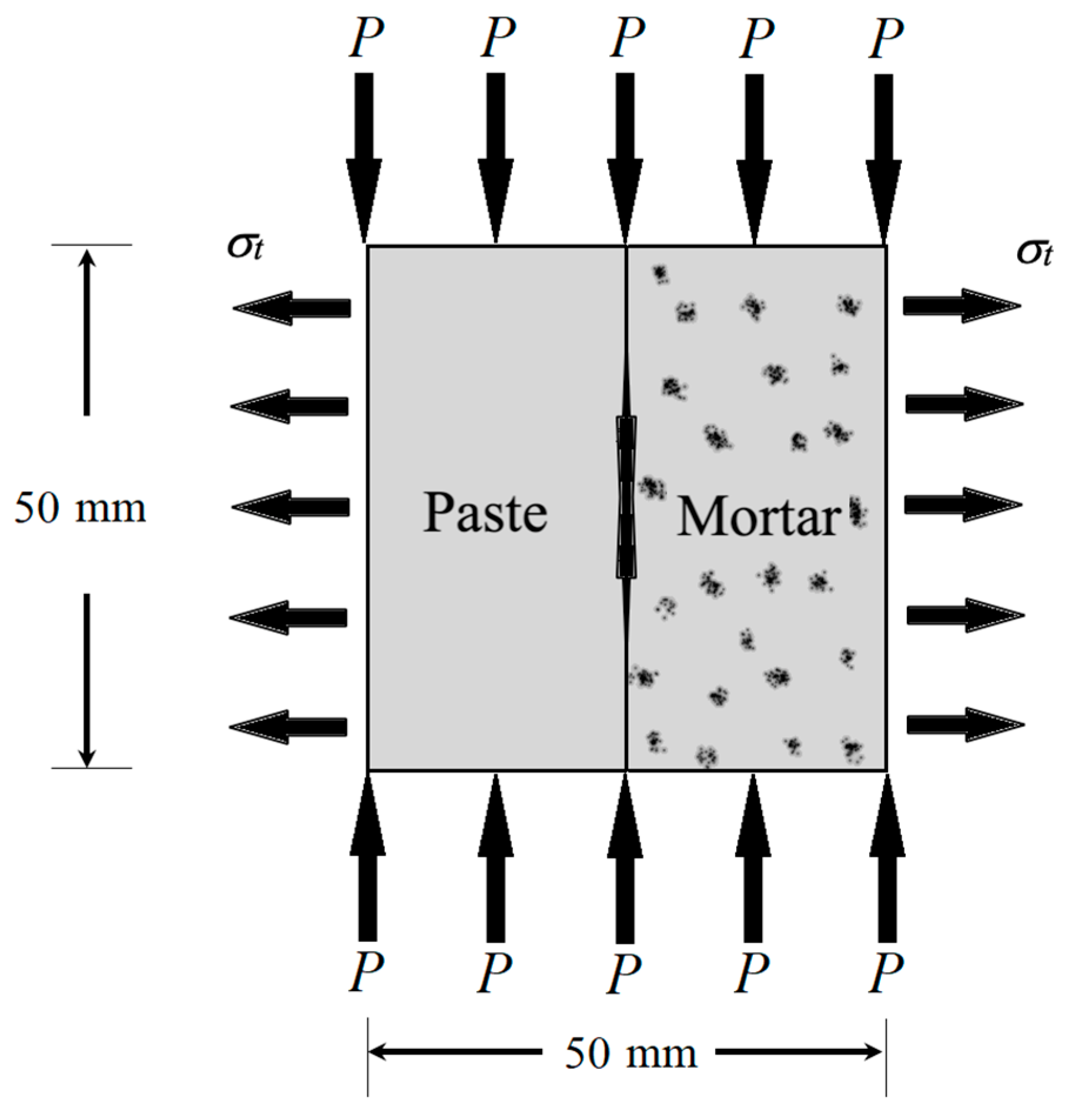

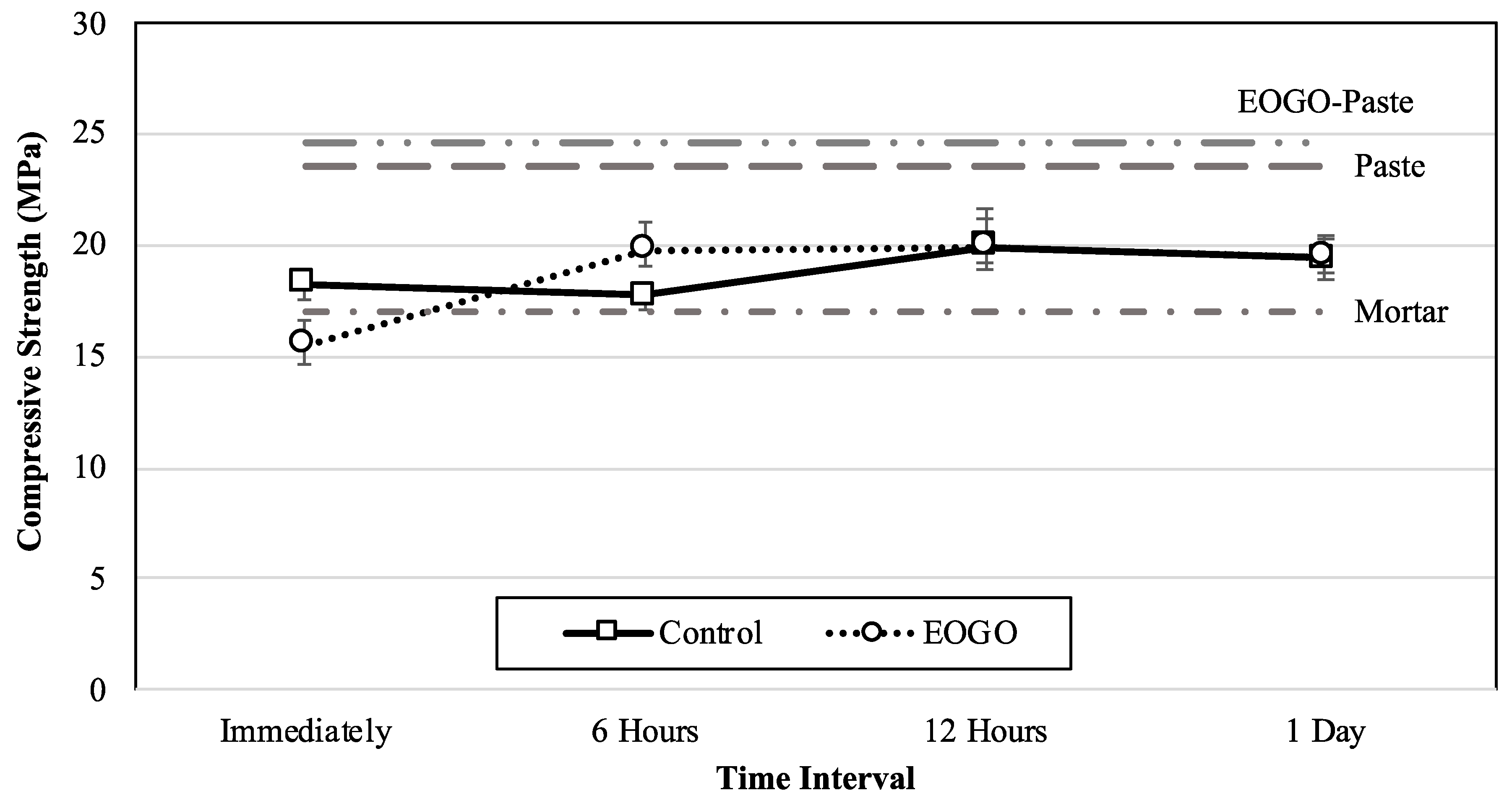
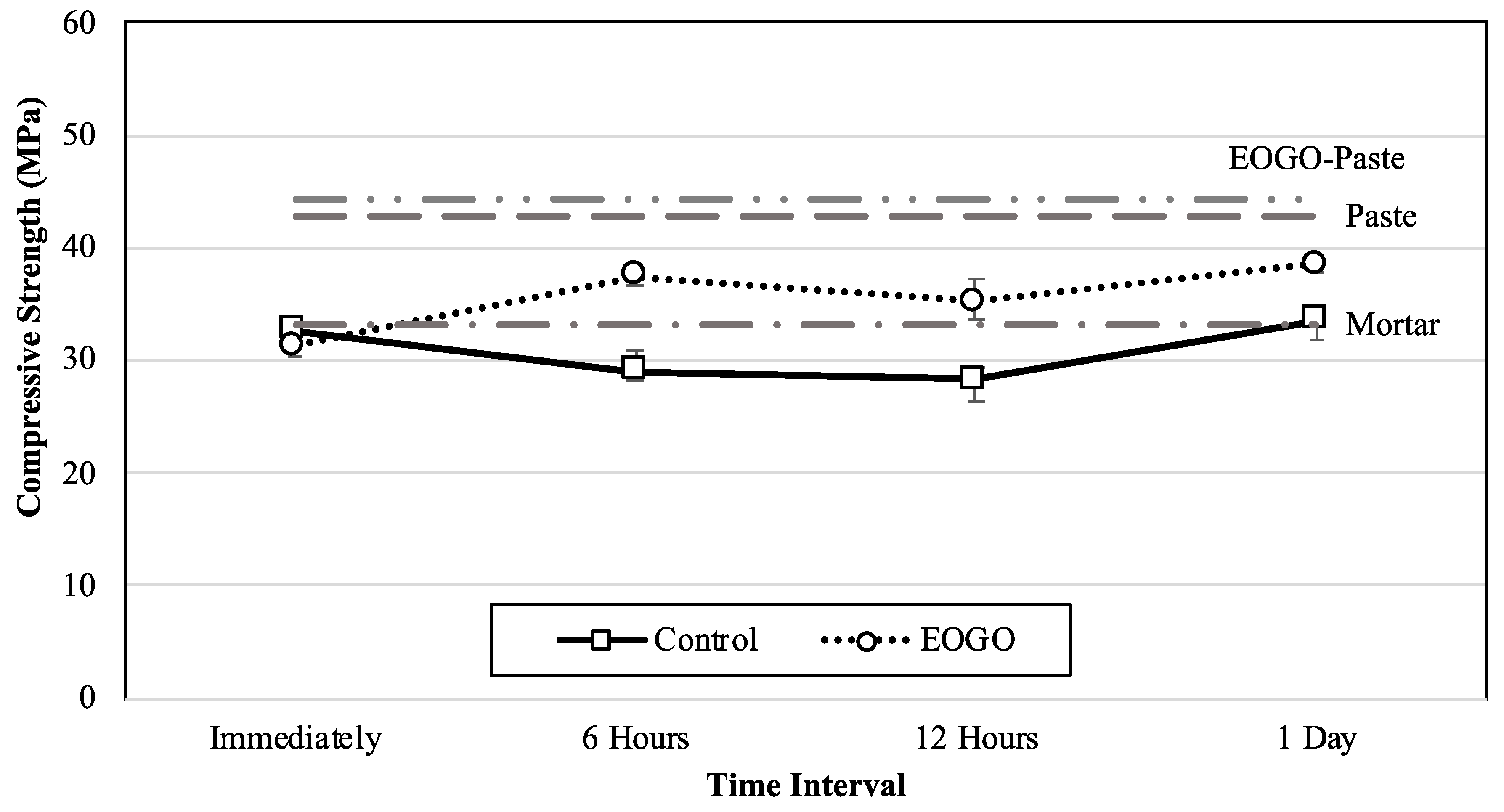

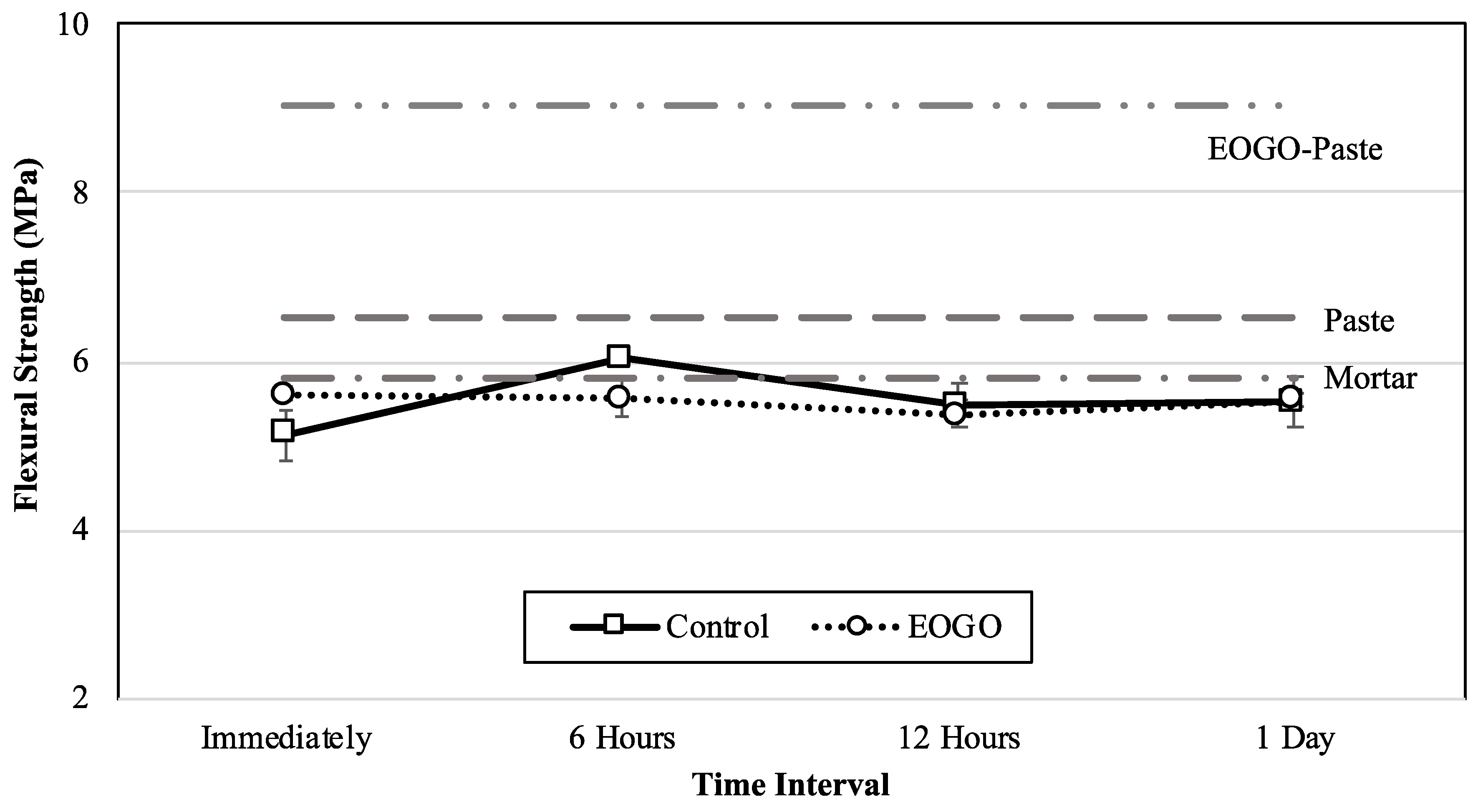
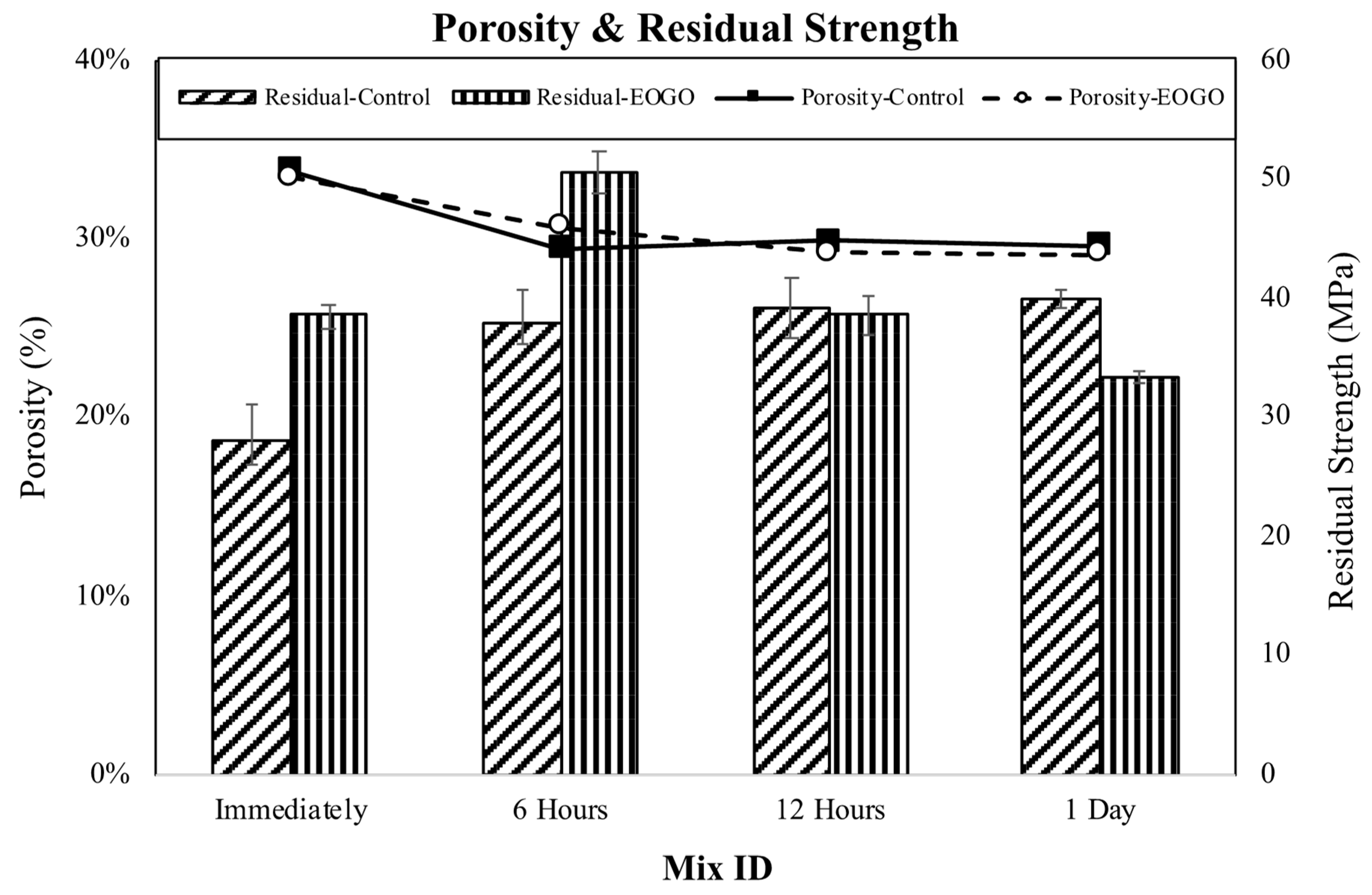


| Mix ID | Layer No. | Water, g | Cement, g | Sand, g | EOGO, g |
|---|---|---|---|---|---|
| Paste | One Layer | 1967 | 4055 | - | - |
| Mortar | One Layer | 901 | 1807 | 4969 | - |
| EOGO-Paste | One Layer | 1967 | 4055 | - | 4.05 |
| All Control Samples | 1 | 451 | 903 | 2484 | - |
| 2 | 983 | 2028 | - | - | |
| All EOGO Samples | 1 | 451 | 903 | 2484 | - |
| 2 | 983 | 2028 | - | 2.02 |
| Group #1 (Control—Immediately) | Group #2 (Immediately) | p-Value | Significance | |||||
|---|---|---|---|---|---|---|---|---|
| Value (Mean) | Standard Deviation | Variance | Value (Mean) | Standard Deviation | Variance | |||
| Compressive (7 days) | 18.29 | 0.71 | 0.51 | 15.49 | 1.04 | 1.09 | 0.0092 | Yes |
| Compressive (28 days) | 32.59 | 1.25 | 1.56 | 31.31 | 1.44 | 2.06 | 0.1543 | No |
| Flexural (7 days) | 3.00 | 0.45 | 0.20 | 2.79 | 0.14 | 0.02 | 0.2406 | No |
| Flexural (28 days) | 5.13 | 0.30 | 0.09 | 5.60 | 0.08 | 0.01 | 0.0292 | Yes |
| Group #1 (Control—6 h) | Group #2 (6 h) | p-Value | Significance | |||||
|---|---|---|---|---|---|---|---|---|
| Value (Mean) | Standard Deviation | Variance | Value (Mean) | Standard Deviation | Variance | |||
| Compressive (7 days) | 17.73 | 0.66 | 0.44 | 19.80 | 1.05 | 1.09 | 0.0223 | Yes |
| Compressive (28 days) | 29.00 | 1.59 | 2.54 | 37.39 | 0.67 | 0.44 | 0.0005 | Yes |
| Flexural (7 days) | 3.78 | 0.16 | 0.03 | 3.54 | 0.08 | 0.01 | 0.0416 | Yes |
| Flexural (28 days) | 6.04 | 0.08 | 0.01 | 5.56 | 0.23 | 0.05 | 0.0127 | Yes |
| Group #1 (Control—12 h) | Group #2 (12 h) | p-Value | Significance | |||||
|---|---|---|---|---|---|---|---|---|
| Value (Mean) | Standard Deviation | Variance | Value (Mean) | Standard Deviation | Variance | |||
| Compressive (7 days) | 19.99 | 1.45 | 2.09 | 19.93 | 1.10 | 1.21 | 0.4809 | No |
| Compressive (28 days) | 28.24 | 1.53 | 2.33 | 35.21 | 1.79 | 3.22 | 0.0034 | Yes |
| Flexural (7 days) | 3.66 | 0.32 | 0.10 | 3.59 | 0.26 | 0.07 | 0.3984 | No |
| Flexural (28 days) | 5.48 | 0.23 | 0.05 | 5.36 | 0.18 | 0.03 | 0.2690 | No |
| Group #1 (Control—1 Day) | Group #2 (1 Day) | p-Value | Significance | |||||
|---|---|---|---|---|---|---|---|---|
| Value (Mean) | Standard Deviation | Variance | Value (Mean) | Standard Deviation | Variance | |||
| Compressive (7 days) | 20.97 | 2.89 | 8.35 | 19.51 | 0.89 | 0.80 | 0.2241 | No |
| Compressive (28 days) | 35.85 | 1.65 | 2.73 | 26.13 | 0.24 | 0.06 | 0.0003 | Yes |
| Flexural (7 days) | 3.40 | 0.30 | 0.09 | 3.38 | 0.21 | 0.05 | 0.4766 | No |
| Flexural (28 days) | 5.52 | 0.30 | 0.09 | 5.54 | 0.08 | 0.01 | 0.4661 | No |
Disclaimer/Publisher’s Note: The statements, opinions and data contained in all publications are solely those of the individual author(s) and contributor(s) and not of MDPI and/or the editor(s). MDPI and/or the editor(s) disclaim responsibility for any injury to people or property resulting from any ideas, methods, instructions or products referred to in the content. |
© 2024 by the authors. Licensee MDPI, Basel, Switzerland. This article is an open access article distributed under the terms and conditions of the Creative Commons Attribution (CC BY) license (https://creativecommons.org/licenses/by/4.0/).
Share and Cite
Khawaji, M.; Alamri, M. The Optimum Interval Time of Layered Cement Composites with the Incorporation of Edge-Oxidized Graphene Oxide. Buildings 2024, 14, 2307. https://doi.org/10.3390/buildings14082307
Khawaji M, Alamri M. The Optimum Interval Time of Layered Cement Composites with the Incorporation of Edge-Oxidized Graphene Oxide. Buildings. 2024; 14(8):2307. https://doi.org/10.3390/buildings14082307
Chicago/Turabian StyleKhawaji, Mohammad, and Mohammed Alamri. 2024. "The Optimum Interval Time of Layered Cement Composites with the Incorporation of Edge-Oxidized Graphene Oxide" Buildings 14, no. 8: 2307. https://doi.org/10.3390/buildings14082307





